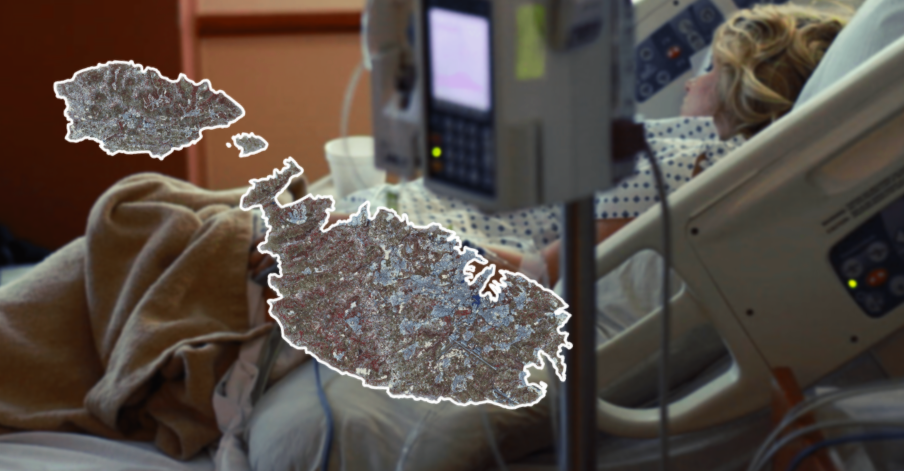EXPLAINED: The State Of Euthanasia In Malta, Europe, And Around The World

In recent years, Malta’s ‘pro-life versus pro-choice’ debate has been entirely focused on abortion, but as the years pass, little to no legislative change seems to have been instigated by said talks. But whilst Malta’s abortion debate remains overwhelmingly divisive, the general public seems to be warming up to the scarcely-discussed practice that is euthanasia.
So whether you’d like to gain a better understanding of this controversial practice or simply form an opinion, here’s everything you need to know about euthanasia.

What is euthanasia?
In short, euthanasia refers to the practice of deliberately ending a person’s life to relieve pain and suffering. Having said that, there are a number of iterations of the act which come with their own set of legal and ethical implications. The three main types of euthanasia, i.e. voluntary, non-voluntary, and involuntary, are distinguished by the extent of their regard for the patient’s consent.
Non-voluntary euthanasia can happen when the person is not able to give consent, like when the patient is a minor or in a vegetative state.
These three types of euthanasia can be further classified into two sub-categories – active, and passive.
In passive euthanasia, patients aren’t actively killed, rather, they are left to die through the conscious decision to withdraw or withhold treatment. Withdrawing treatment refers to the switching off of a vital machine.
Conversely, active euthanasia takes place when a medical practitioner administers lethal substances or forces.
Two lesser-known facets of euthanasia are indirect euthanasia and physician-assisted suicide.
Physician-assisted suicide is not always considered a form of euthanasia due to the fact that it is the patient themselves that ultimately administer the lethal drug.
Indirect euthanasia is one of the least common forms of euthanasia out there. This refers to when a patient is administered treatment – oftentimes to alleviate pain – that has the side effect of speeding their death.

What is the law in Malta?
Active euthanasia and assisted suicide are illegal in Malta.
Assisted suicide is considered a crime and is punishable by up to 12 years in prison. On the other hand, the withdrawal of treatment – a form of passive euthanasia – and palliative sedation are legal and, as of 2016, were carried out by 15% and 7.5% of doctors in Malta respectively.
Palliative sedation is the practice of relieving a terminally-ill patient’s pain and/or distress through the administration of sedative drugs.
Whilst patients in Malta have a right to refuse life-saving treatment and medication, as of yet, there are no laws regulating ‘living wills’.
A living will is a written statement, penned when an individual is of sane mind and body, detailing said person’s desires regarding what type of medical treatment they would and/or would not like to receive if they are ever unable to communicate their wishes.

Where is euthanasia and physician-assisted suicide legal?
Despite growing support for the practice, active euthanasia is only legal in a handful of countries around the world. Having said that, euthanasia and physician-assisted suicide are far more available and accepted in the Western world. These are some countries whose legislation favours these practices.
New Zealand
New Zealand was the latest country to legalise euthanasia. In a referendum last October, 65.2% of eligible citizens voted in favour of legalising the practice, whilst 33.8% voted against. Kiwis were also given the choice to legalise cannabis in the same referendum, although a majority of 53.1% voted against. Both Prime Minister Jacinda Ardern and opposition leader Judith Collins backed the legalisation of euthanasia.
This referendum will see the End Of Life Choice act come into effect 12 months after the final results, i.e. on 6th November 2021. The act will allow thus allow terminally ill people with less than six months to live to choose assisted dying, if approved by two doctors. People who apply to end their life under this act must also be aged 18 or over, New Zealand citizens, and in a position to make an informed decision about their death.
Australia
In Australia, it is the state government or federal government that handles the issue of euthanasia. The state of Victoria was the first Australian state to pass legislation allowing assisted suicide, back in 2019. A similar scheme will be in effect in Western Australia in mid-2021. As of yet, voluntary euthanasia and assisted suicide are illegal in all other Australian states and territories.
The Voluntary Assisted Dying Act of 2017, which came into effect in Victoria in 2019, dictates that only people who are suffering from an incurable disease, illness, or medical condition, and are experiencing intolerable suffering can apply for the practice. Furthermore, applicants must be over the age of 18, and their condition must be expected to cause death within six months. Once such criteria are met and the case is approved by two separate doctors, the patient will be prescribed lethal medication.
Germany
Physician-assisted suicide was made legal in Germany last February after the country’s highest court overturned a ban on the practice. This ruling came after a group of doctors, patients, and proponents sued to change the law of assisted suicide. They had argued that the measure infringed on their constitutional right to make decisions about their own lives.
Passive euthanasia through the withdrawal of life support is also legal in Germany, however active euthanasia is not.
Belgium
Belgium legalised voluntary euthanasia and physician-assisted suicide for competent adults back in 2002. If a patient is not terminally ill, there is a one-month waiting period before euthanasia can be performed. All instances of euthanasia or physician-assisted suicides are reported to a Control and Evaluation Commission.
In 2003, the Belgian Senate ruled that euthanasia can be administered to terminally-ill children, provided that the patient is conscious of their decision and can understand the meaning of ‘euthanasia’. Furthermore, the request must be approved by the child’s parents and a medical team. In 2016, the first minor was euthanised under these regulations.
Since the law was introduced in 2002, there have been around 1,400 cases of euthanasia a year in Belgium. The record number of cases was 1,807 in 2013.
Colombia
Back in 1997, Colombia’s Supreme Court ruled that penalties for mercy killing should be removed and doctors are permitted to end patients’ lives by euthanasia. Having said that, the decision to legalise the practice was delayed until guidelines for it were approved by the Colombian Congress.
Congress approved said guidelines 18 years later, in 2015, making it legal for doctors to practice euthanasia by lethal injection. In 2018, Colombia passed a resolution permitting euthanasia for children.
Canada
In 2015, the Supreme Court of Canada unanimously ruled that Canadian adults who are mentally competent and suffering intolerably and permanently have the right to a doctor’s help in dying. A year later, in 2016, the Parliament of Canada passed federal legislation that allows eligible Canadian adults to request medical assistance in dying.
In order to be eligible for medical assistance in dying in Canada, an individual must be Canadian, at least 18-years old, mentally competent, and suffering from a grievous and irremediable medical condition. There are two ways by which the practice can take place; either a medical practitioner administers the lethal substance, or the practitioner prescribes the lethal substance which the patient then administers themselves.

Arguments for and against euthanasia
People’s opinions and understandings of euthanasia are often dictated by their religious beliefs. Christians, for example, argue that life is given by God, and therefore no human being has the authority to take the life of any innocent person – even if they want to die.
Religious arguments aside, here we will be focusing on ethical and moral arguments for and against the practice.
Arguments for euthanasia
The main argument in favour of euthanasia concerns the concept of self-determination, i.e. the right of the individual to determine what happens to them. Those who abide by this argument believe that human beings should have the right to choose when and how they die.
A number of pro-euthanasia arguments stem from this. Followers of this movement believe that giving patients the right to choose when and how they die subsequently puts them in control of their situation and thus allows them to die with dignity. Furthermore, one can argue that ultimately, death is a private matter in which the state shouldn’t interfere.
The pragmatic argument for euthanasia puts a spotlight on similar end-of-life practices that are widely accepted but are essentially types of euthanasia in all but name.
A do-not-resuscitate order, for example, is widely legal and accepted. Having said that, pro-euthanasia activists believe that essentially, do-not-resuscitate orders are a form of passive euthanasia, wherein a person is being denied potentially life-saving treatment.
The same goes for palliative sedation. Whilst the primary aim of this practice is to lessen a patient’s suffering, the sedatives used in the process pose the risk of shortening the patient’s lifespan. In light of this, one can argue that palliative sedation is a form of active euthanasia.
Arguments against euthanasia
Most pro-life activists quote the slippery slope argument to undermine the legitimacy of euthanasia. This states that once it is legal for a medical institution, and thus, the state, to kill patients, a dangerous precedent is set. Supporters of this argument thus believe that once voluntary euthanasia is legalised, it is only a matter of time before non-voluntary and involuntary euthanasia become norms.
On a different note, the ‘medical ethics argument’ against euthanasia states that if a medical practitioner administers euthanasia, they would be in violation of the International Code of Medical Ethics, which states that ‘a doctor must always bear in mind the obligation of preserving human life from conception’.
As a result of this, one can say that euthanasia grants too much power to doctors and medical practitioners. Such power might adversely affect the doctor-patient relationship.
Euthanasia might also serve to put patients in an even more vulnerable position. For starters, the practice might start being considered as a ‘cost-effective’ way of treating terminally-ill patients. Furthermore, if euthanasia is readily available, researchers are discouraged from keeping up the search for new cures and treatments.
What are the country’s leaders saying about euthanasia?
Whilst it seems like Malta is still far from legalising euthanasia, a number of key figures in Malta’s political sphere have come out in favour of this practice.
Shortly after the news came out that New Zealand voted to legalise euthanasia in a referendum, Labour deputy leader Daniel Micallef came out in favour of the practice. Not only so, but he also added that he will be campaigning hard to see “this right come to fruition when the time comes”.
Newly-elected MEP Cyrus Engerer suggested holding a referendum on legalising euthanasia, adding that he “really likes” the way New Zealand handled the issue.
In a bid to understand what Malta’s MPs think about euthanasia, Lovin Malta had conducted a vox pop earlier this month. Some spoke in favour of the practice, some vehemently against, whilst others refused to disclose their personal stance on the topic.
Environment Minister Aaron Farrugia came out wholeheartedly in favour of euthanasia, and he even had a couple of strong words to support his position. “I believe that a person who is in extreme pain – an experience which I’ve witnessed first hand – should have control over their own body,” Farrugia said.
Similarly, Home Affairs Minister Byron Camilleri and newcomer MP Miriam Dalli both expressed their support towards the practice, provided that it’s controlled.
On the other hand, PN MP Beppe Fenech Adami, Junior Minister Clifton Grima, and former-Finance Minister Edward Scicluna all wholeheartedly disagreed with euthanasia.
Parliamentary Secretary for Active Ageing Silvio Parnis stood firmly by his Catholic views and kept insisting that he’s ‘pro-life’. Parnis was one of the new Labour MPs to completely shoot down euthanasia. Similarly, Arts Minister Jose Herrera highlighted that the practice goes against his morals.
Foreign Affairs Minister Evarist Bartolo and Education Minister Owen Bonnici both refused to outwardly support euthanasia, however, they insisted that it is key to consider the practice on a case-by-case basis.

In conclusion
Euthanasia remains an extremely convoluted issue which requires thorough regulation wherever it is legalised. Having said that, the practice seems to be gaining a fair share of support from citizens all over the world – Malta included. Whilst no formal bodies have come out in favour of the practice locally, it seems like the general public is becoming more inclined to fight for its right to a dignified death.
Resistance against the practice seems to be stemming mainly from the country’s staunch Catholics, who firmly believe that it is only God who has the right to give and take away life. In fact, the main arguments being posed against euthanasia here in Malta are overwhelmingly religious.
Despite the growing support for the practice, euthanasia hasn’t yet become a major talking point for Malta’s leaders, and unless Malta’s pro-choice community stands up to be counted, it seems like that will be the case for years to come.
If there’s anything that Malta can learn from New Zealand, it’s how impactful serious campaigning from the general public can be.
Do you think euthanasia should be introduced in Malta? Comment below